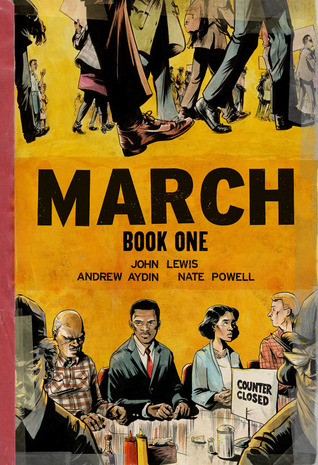Lewis, John and Andrew Aydin; illus. by Nate Powell. March Vol. 1. New York : Top Shelf Productions, 2013. 128 pages, grade 6 and up.
TL;DR version can be found here: March Vol. 1 by John Lewis
TL;DR version can be found here: March Vol. 1 by John Lewis
I consider myself fairly educated in American History and feel like my high school American History courses went in depth into the 1960s and the Civil Rights Movement. How is it then that although John Lewis’ name sounded familiar, I honestly could not place it in context? The more I read about this time period, the more I am aware that I know the broad strokes but I am woefully lacking in specifics. I had a similar realization after reading No Crystal Stair and feeling like all I knew about Malcolm X was his name and he wore glasses. Thankfully, we appear to be experiencing a boom of great children’s literature about the Civil Rights Movement and the history of racism in this country that will help educate this generation about the people, not just the events.
March Vol. I, uses President Obama’s 2009 inauguration as a framing device for John Lewis to tell the story of his childhood and how he ended up involved with the Nashville sit-ins in 1960. His interest in becoming a priest and nonviolence begins in his family’s chicken coop, where a young Lewis (nicknamed Bob from his middle name) preaches to his hens and protests his parents against their doomed dinner table fates. An eye-opening trip up North to Buffalo, NY with an uncle, running away from working in the fields to go to school, hearing Dr. Martin Luther King Jr. on the radio and reading about the Brown v. Board of Education court case all are important influential steps on his way to becoming the famed activist politician he is known for today.
This is a powerful book and uses the graphic novel form well. Powell’s drawings are often loose, sketchy and filled with movement but they are tightened in places to highlight a dramatic scene or an important plot point. There are some more stylized panels to balance the intense realism and can be seen as a shorthand to give the reader some understanding of Lewis’ internal narrative. Powell illustrated another Civil Rights era book last year, The Silence of Our Friends, and I think his art has improved. These two books could be paired well together to give additional historical context (and an African-American perspective) to the more personal story told in Friends. March Vol. I has been very well received critically, receiving a Coretta Scott King Honor Award and placing in YALSA’s Top 10 Great Graphic Novels for Teens and Outstanding Books for the College Bound lists. Powell noted on his Goodreads page that March has replaced two other historical graphic novels, Persepolis and Maus. I think it deserves a place on that list, but why can’t it exist alongside other graphic novels, why can there only be one? Those two books are great for teens to understand foreign cultures and I think removing them from the list and replacing them with a US history book is an isolationist move. Regardless of that one list’s mistakes, March will soon become required reading in many middle and high school history classes and in my mind, the more visual literature that is incorporated, the better. Although the writing can be a bit bland and formulaic - this could be a tone adjustment for younger readers and a consequence of the “Well, when I was a boy...” storytelling - the plot moves quickly and I am eagerly awaiting the next two volumes.
Highly recommended. Grades 6 and up. There are a few depictions of violence - Emmett Till’s body is shown but it is not too graphic - and some language.


No comments:
Post a Comment